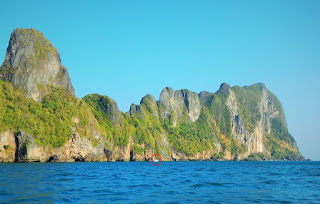Finally he figured it was the windlass, and upon investigating, Jordan found that the remote switch that's kept in the forward outside anchor locker had gotten seawater in it and it was shorting the internal contact as though the switch button was pressed to make the windlass go on.
So temporarily we switched off the windlass breaker but then, before we raised the hook on the 29th, a fix was necessary. (We don't need the windlass to drop anchor but it sure is nice for raising the heavy anchor!) The disassembled switch was easily rinsed and cleaned with dialectic oil and was good to go. So it wasn't until 09:00 that we pulled up and made tracks from Koh Phetra.
Our destination was another island new to us, named Koh Muk, a pleasant 5.5-hour beam reach sail away. Tucking in close to a cute beach flanked by towering limestone sentinels made for a splendid anchorage setting (N07°22.503' E099°17.187') in spite of the occasional noisy longtails with daytrippers from the mainland.
A Koh Muk moment
The main attraction here is Emerald Cave (aka Crystal Cave) which the cruising guide described as being accessed by a cave passage at sea level, 80 metres long most of which was in pitch blackness. The passage is punctuated at a small sandy, grey silica beach in an ethereal cave open to sky.
We decided to explore it the next morning before the tourists infested the contemplative nature of it all. But this first day, once the gawkers evaporated later that afternoon, we launched the dinghy to simply identify where the waterline cave entrance was which we easily found.
Shutting off the motor, we paddled just inside but without a flashlight, the interior passage quickly turned into a foreboding inky blackness stopping us short.
However on our retreat, a couple of other late yachtie arrivals in dinghies were coming in and invited us to follow with one of their extra flashlights. Paddling along through this surreal natural passage with the faint light showing eerie outlines of stalactites in the cavities above and other dead-end passages emanating ghostly whooshes conjured up images of a spooky Disneyland event. Motoring your dinghy in apparently is not allowed as it supposedly disturbs the bat population of the Cave. I guess someone motored in before us because we didn't see any evidence of bats which is too bad because that would have been the only thing missing to make it an all round creepy experience!
The end of the cave passage opened up in an ethereal setting of an inner cylindrical chamber a mere 60 metres in diameter completely surrounded by tall vertical limestone walls. Standing on the small sandy beach where even the few spoken words took on an otherworldly resonance, our sights were drawn up, up along vertical rock face laced with verdant lush growth to the late day's sky high above.
Inside Emerald Cave
(Flashlights can be seen in the dark passage above as more dinghies arrive.)
Even though we did the Cave thing the day of arrival, we decided to stay another day in this idyllic setting. Another boat job was needed (bleed some air out of the hydraulic steering ram) so Jordan did it this morning. Then the rest of the day we circumnavigated Koh Muk with the dinghy through some choppy waters at times and then did a lazy snorkel in the shadow of the cliffs' relatively clear and warm waters.















